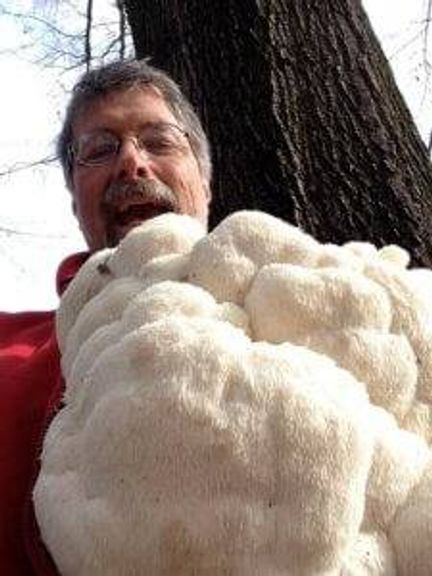How I Make $200-an-Hour Foraging for Mushrooms
It started out as a hobby but mushroomed into a nice income
It wasn't part of a business plan, but a 33-pound wild edible mushroom growing in the woods on the edge of town six years ago was my first sale to chefs in downtown Durham, N.C. I pocketed $351 in less than three hours.
Lion’s mane, an unusually large mushroom, favors winter weather. It was completely covered by a layer of inch-long, white whiskers — hence the name. This one was so high up on an oak tree, that to gather it, I had to stand on top of my eight-foot stepladder. Clinging to the tree, with my wife’s bread knife in hand and the smell of fresh mushroom in my face, I carved that meaty monster up.
Mushrooms as Faux Crab Cakes
I brought it home in five grocery bags, each stuffed full like a big guy wearing a little guy’s t-shirt. Lion’s mane has the color and texture of crabmeat; I like to fry it up as patties of faux crab cakes. But I couldn’t imagine eating that much. So I put one bag in the fridge and told my disbelieving spouse that I was heading back out to sell the rest to restaurants, while the lion’s mane was fresh. I came back two hours later, waving half-a-dozen checks in my fist.
For prime condition edible mushrooms, chefs are paying about as much per pound as you would for New York strip steak or even filet mignon: about $12 to $25 a pound. A single five-pound “chicken of the woods” mushroom is bigger than a loaf of bread and could earn you $100.
Before that first day with my lion’s mane, I never thought I’d make a dime foraging mushrooms. When I’m not writing, I’m creating gardens for clients. Seven years ago, I had signed up for my first mushroom walk because I like the outdoors and I like food. I thought maybe I’d meet some nature lovers (I did) and come home with a basket of fancy mushrooms (I did not).

Getting Hooked on Foraging for Mushrooms
But I was hooked. Foraging for mushrooms felt like a treasure hunt for grown-ups. To my surprise, those hunts now fetch real treasure — on the order of $200-an-hour or $2,000 to $3,000 a year. To save time (which increases my hourly pay), I’ve learned to keep a notebook with an inventory of dates and locations so I can revisit productive trees and add new ones as I find them.
Heavy rains last October birthed flushes of maitake, chicken-of-the-woods and lion’s mane edible mushrooms that grow on trees I’d found in earlier seasons. Foraging sporadically between Columbus Day and Thanksgiving, I harvested about 120 pounds of those three fungi. When all was said and done and eaten, I had made over $2,500 from about a dozen hours of foraging and selling.
At that rate of pay, it would be tempting to try to make a full-time living from foraging. I know some people who do, but I don’t take my hobby that far. As a decades-long member of the gig economy I already have a collection of moneymakers: managing political campaigns, selling my photos to magazines, building stonewalls. Foraging gives me one more way to keep my greatest fear — a day job — at bay.
Fun With Fungi
For the self-employed and semi-retired, seasonal foraging can fill your basket with high-dollar food, outdoor fun and perhaps even some quick cash. You don’t have to be a mycologist (someone who studies fungi) to learn to tell edible mushrooms from poisonous ones; you just have to be a careful person and refuse to eat or share anything you’re not 100 percent certain about.
That certainty only comes from being personally introduced to edible mushrooms by someone who’s eaten them. Of the thousands of species of mushrooms in a given region, much fewer than 100 are edible; another 250 are poisonous. But the poisonous ones often taste good (so I hear), so don’t play the odds.
The best way for a novice to start would be to ask Mr. Google to locate a forager in your region or in a mushroom-rich area where you plan to travel. You may find the website of a professional forager — like Wildman Steve Brill in New York or Alan Muskat in North Carolina — or you’ll find an article about one. Contact the mushroom maven and sign up for classes or express your interest and offer to hire the pro to teach you.

Books and Accessories for Mushroom Hunters
To reinforce your newfound knowledge, pick up a brace of books. A regional guidebook to mushrooms is the best place to start, and back that up with Michael Kuo’s 100 Edible Mushrooms. Those two and Ellen Zachos’ Backyard Foraging make a good trio; Zachos covers a few of the most common mushrooms as well as the most common edible plants found in gardens.
You may also find foraging groups in your area on Facebook or Meetup.com that go on forays where individuals share their knowledge.
Finally, pick up the right accessories. A notebook to keep an inventory of dates and locations of your finds. A pocket knife for harvesting. A paintbrush to dislodge debris without damaging your finds. Plastic bags for foraged plants and paper bags for mushrooms so they don’t rot. A basket or a daypack to carry your finds.
Do I worry about poisonous mushrooms? In the rest of my life I’ve found success by making risky choices. But we foragers have a saying: “There are old mushroom hunters. There are bold mushroom hunters. But there are no old, bold mushroom hunters.”
So take the careful steps I’ve recommended and we can all be old mushroom hunters one day.
Next Avenue Editors Also Recommend:
.

